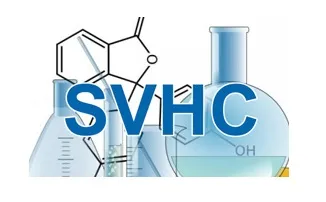
Update of Bisphenol A
ECHA has decided to update the description of BPA in the Candidate List to reflect one more reason for the inclusion of BPA in that List. In reality, this substance has endocrine disrupting properties and would also have adverse effects on the environment.
What is the Candidate List?
The Candidate List is a list of substances that may have serious effects on human health or the environment. Substances on the Candidate List are also known as SVHCs (Substances of Very High Concern) and are candidates for inclusion in Annex XIV of substances subject to authorisation. Once on this list, the industry will have to submit an application for permission to continue using the substances after the Sunset Date.
To learn more about the mechanisms of inclusion of substances in these different regulatory lists, do not hesitate to consult our page on securing substances.
The list of substances included/updated in the Candidate List for Authorisation and their SVHC properties
Substance nameEC numberCAS numberReason for inclusionExamples of use 4,4’-isopropylidenediphenol (bisphenol A; BPA) 201-245-8 80-05-7 Endocrine disrupting properties (Article 57(f) - environment) Manufacture of polycarbonate, as a hardener for epoxy resins, as an anti-oxidant for processing PVC and in thermal paper production. Chrysene 205-923-4 218-01-9 Carcinogenic (Article 57a) PBT (Article 57d) vPvB (Article 57e) Normally not produced intentionally but rather occurs as a constituent or impurity in other substances. Benz[a]anthracene 200-280-6 56-55-3 Carcinogenic (Article 57a) PBT (Article 57d) vPvB (Article 57e) Normally not produced intentionally but rather occurs as a constituent or impurity in other substances. Cadmium nitrate 233-710-6 10325-94-7 Carcinogenic (Article 57a)Mutagenic (Article 57b) Specific target organ toxicity after repeated exposure (Article 57(f) - human health) Substance used for the manufacture of glass, porcelain and ceramic products and in laboratory chemicals. Cadmium hydroxide 244-168-5 21041-95-2 Carcinogenic (Article 57a)Mutagenic (Article 57b) Specific target organ toxicity after repeated exposure (Article 57(f) - human health) Substance used for the manufacture of electrical, electronic and optical equipment and in laboratory chemicals. Cadmium carbonate 208-168-9 513-78-0 Carcinogenic (Article 57a)Mutagenic (Article 57b) Specific target organ toxicity after repeated exposure (Article 57(f) - human health) Substance used as a pH regulator and in water treatment products, laboratory chemicals, cosmetics and personal care products. 1,6,7,8,9,14,15,16,17,17,18,18-Dodecachloropentacyclo[12.2.1.16,9.02,13.05,10]octadeca-7,15-diene (“Dechlorane Plus”TM) [covering any of its individual anti- and syn-isomers or any combinationthereof] - - vPvB (Article 57e) Substance used as a non-plasticising flame retardant, used in adhesives and sealants and in binding agents. Reaction products of 1,3,4-thiadiazolidine-2,5-dithione, formaldehyde and 4-heptylphenol, branched and linear (RP-HP) [with ≥0.1% w/w 4-heptylphenol, branched and linear] - - Endocrine disrupting properties (Article 57(f) – environment) Substance used as a lubricant additive in lubricants and greases.
What is involved when including a substance in the Candidate List
The inclusion of a substance in the Candidate List implies new regulatory obligations for the companies that use it. These obligations may apply both to single substances and to mixtures or articles.
Downstream communication obligation
Specifically, any supplier of an article containing a substance in the Candidate List with a mass concentration of more than 0.1% has an obligation to communicate to downstream users and consumers. This communication concerns at least the name of the SVHC substance (s) present in the article at a concentration of more than 0.1%.
For companies that market products to the general public, this information must be available to a consumer within 45 days of the request.
Notification obligation to ECHA
In addition, importers and producers of articles containing substances in the SVHC list have six months from the date of inclusion of the substance in the Candidate List, ie 15 January 2018 to notify ECHA, if the total tonnage of SVHC substance exceeds 1 tonne per year in marketed articles. However, there are exemptions to this notification requirement.
Information on these obligations and associated tools are available on ECHA's website.
Update of Bisphenol A
ECHA has decided to update the description of BPA in the Candidate List to reflect one more reason for the inclusion of BPA in that List. In reality, this substance has endocrine disrupting properties and would also have adverse effects on the environment.
What is the Candidate List?
The Candidate List is a list of substances that may have serious effects on human health or the environment. Substances on the Candidate List are also known as SVHCs (Substances of Very High Concern) and are candidates for inclusion in Annex XIV of substances subject to authorisation. Once on this list, the industry will have to submit an application for permission to continue using the substances after the Sunset Date.
To learn more about the mechanisms of inclusion of substances in these different regulatory lists, do not hesitate to consult our page on securing substances.
The list of substances included/updated in the Candidate List for Authorisation and their SVHC properties
Substance nameEC numberCAS numberReason for inclusionExamples of use 4,4’-isopropylidenediphenol (bisphenol A; BPA) 201-245-8 80-05-7 Endocrine disrupting properties (Article 57(f) - environment) Manufacture of polycarbonate, as a hardener for epoxy resins, as an anti-oxidant for processing PVC and in thermal paper production. Chrysene 205-923-4 218-01-9 Carcinogenic (Article 57a) PBT (Article 57d) vPvB (Article 57e) Normally not produced intentionally but rather occurs as a constituent or impurity in other substances. Benz[a]anthracene 200-280-6 56-55-3 Carcinogenic (Article 57a) PBT (Article 57d) vPvB (Article 57e) Normally not produced intentionally but rather occurs as a constituent or impurity in other substances. Cadmium nitrate 233-710-6 10325-94-7 Carcinogenic (Article 57a)Mutagenic (Article 57b) Specific target organ toxicity after repeated exposure (Article 57(f) - human health) Substance used for the manufacture of glass, porcelain and ceramic products and in laboratory chemicals. Cadmium hydroxide 244-168-5 21041-95-2 Carcinogenic (Article 57a)Mutagenic (Article 57b) Specific target organ toxicity after repeated exposure (Article 57(f) - human health) Substance used for the manufacture of electrical, electronic and optical equipment and in laboratory chemicals. Cadmium carbonate 208-168-9 513-78-0 Carcinogenic (Article 57a)Mutagenic (Article 57b) Specific target organ toxicity after repeated exposure (Article 57(f) - human health) Substance used as a pH regulator and in water treatment products, laboratory chemicals, cosmetics and personal care products. 1,6,7,8,9,14,15,16,17,17,18,18-Dodecachloropentacyclo[12.2.1.16,9.02,13.05,10]octadeca-7,15-diene (“Dechlorane Plus”TM) [covering any of its individual anti- and syn-isomers or any combinationthereof] - - vPvB (Article 57e) Substance used as a non-plasticising flame retardant, used in adhesives and sealants and in binding agents. Reaction products of 1,3,4-thiadiazolidine-2,5-dithione, formaldehyde and 4-heptylphenol, branched and linear (RP-HP) [with ≥0.1% w/w 4-heptylphenol, branched and linear] - - Endocrine disrupting properties (Article 57(f) – environment) Substance used as a lubricant additive in lubricants and greases.
What is involved when including a substance in the Candidate List
The inclusion of a substance in the Candidate List implies new regulatory obligations for the companies that use it. These obligations may apply both to single substances and to mixtures or articles.
Downstream communication obligation
Specifically, any supplier of an article containing a substance in the Candidate List with a mass concentration of more than 0.1% has an obligation to communicate to downstream users and consumers. This communication concerns at least the name of the SVHC substance (s) present in the article at a concentration of more than 0.1%.
For companies that market products to the general public, this information must be available to a consumer within 45 days of the request.
Notification obligation to ECHA
In addition, importers and producers of articles containing substances in the SVHC list have six months from the date of inclusion of the substance in the Candidate List, ie 15 January 2018 to notify ECHA, if the total tonnage of SVHC substance exceeds 1 tonne per year in marketed articles. However, there are exemptions to this notification requirement.
Information on these obligations and associated tools are available on ECHA's website.







